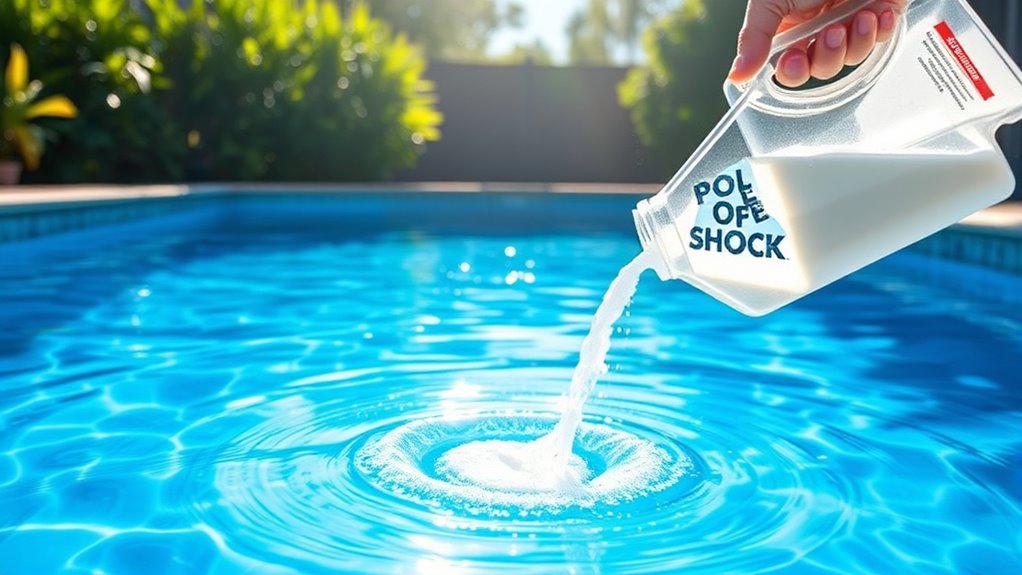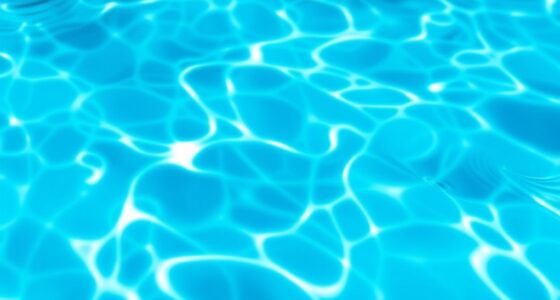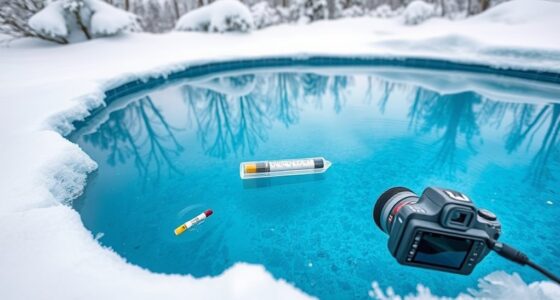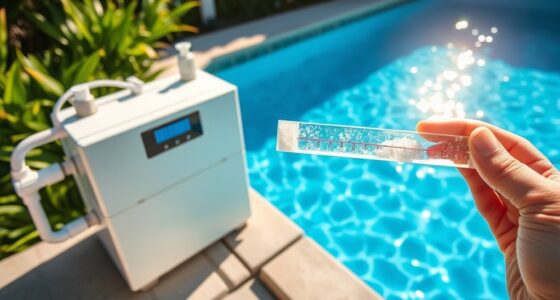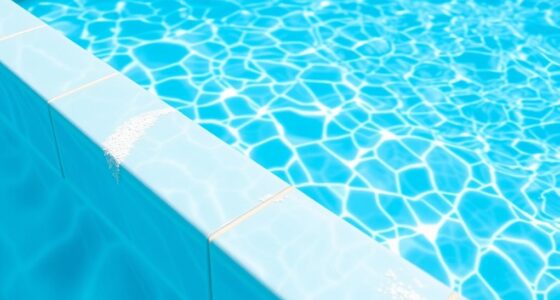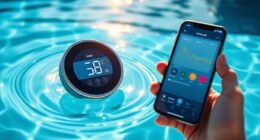To shock your pool, test and balance your water’s pH, alkalinity, and chlorine levels first. Choose the right shock type—chlorine or non-chlorine—based on your needs, then evenly pour it into the water, ideally in the evening or after heavy use. Run the filter for at least 8 hours and avoid swimming until chemicals dissipate. For detailed steps and safety tips, continue exploring how to confidently keep your pool sparkling and safe.
Key Takeaways
- Shock your pool in the evening or at night after sunset for optimal chemical dissipation.
- Test and balance water chemistry (pH, alkalinity) before shocking to ensure effectiveness.
- Apply the shock evenly around the pool, preferably when the water is clear and the pump is running.
- Use the appropriate type of shock (chlorine or non-chlorine) based on your pool’s needs and conditions.
- Wait 8–12 hours after shocking before swimming, allowing chemicals to dissipate and water to clear.
Understanding the Purpose of Pool Shocking

Have you ever wondered why pool owners often shock their pools? Shocking is crucial because it destroys bacteria, algae, and organic contaminants that regular chlorine treatments might miss. Over time, these impurities build up, causing cloudy water, bad odors, and potential health risks. When you shock your pool, you’re adding a large dose of chlorine or a similar chemical to break down these substances quickly. This process also helps restore water clarity and ensures the sanitizer works effectively. Think of shocking as a deep clean that revitalizes your pool’s chemistry. Regular shocking prevents issues before they start, keeping your water sparkling and safe for swimming. Understanding this purpose makes it clear why routine shocks are a essential part of pool maintenance.
Signs Your Pool Needs a Shock Treatment

If your pool water looks cloudy or dull despite regular chlorine levels, it’s a strong sign that your pool needs a shock treatment. Cloudiness often indicates an overload of organic contaminants, bacteria, or algae that normal chlorination can’t eliminate. You might also notice a strong chlorine smell, which means chloramines—byproducts of chlorine reacting with contaminants—are building up. Additionally, if your water has a green tint, algae could be taking hold. Skin or eye irritation while swimming, or a persistent foul odor, are other signs that your pool’s chemical balance is off. These issues suggest that shock treatment is necessary to restore clean, clear, and safe swimming conditions. Recognizing these signs early helps prevent bigger problems and keeps your pool inviting. Regularly testing and adjusting your water chemistry ensures optimal water chemistry of your shock treatments, which is especially important when using specialized chlorine-free or advanced filtration systems.
Choosing the Right Type of Pool Shock

Choosing the right pool shock depends on your pool’s needs and your cleaning routine. Chlorine-based shocks are effective for quick sanitation, while non-chlorine options offer gentler, more convenient treatment. Understanding the differences helps you select the best product to keep your pool sparkling and safe. Properly selecting a shock can also help maintain the positive Dad and Daughter Bond that enhances your overall swimming experience. Additionally, knowing the different types of pool shock can help you make an informed decision based on your pool’s specific requirements. For example, selecting a shock with oxidizing agents can effectively break down organic contaminants and improve water clarity. Incorporating home theater projectors with high contrast ratios can also help you enjoy your poolside entertainment during evening swims. Having knowledge of industry trends can further assist you in choosing the most effective pool maintenance products.
Chlorine-Based Shocks Explained
Are you unsure which chlorine-based shock is best for your pool? There are different options, each suited for specific needs. Fast-dissolving shocks work quickly to restore clarity, while stabilized shocks last longer, especially in sunny conditions. You might also consider calcium shocks if your water’s hardness is low, but avoid using them with vinyl liners. Here’s a quick comparison:
| Type | Best for | Key Benefit |
|---|---|---|
| Quick Dissolving | Emergency chlorination, quick fixes | Rapid results |
| Stabilized | Sun-exposed pools | Longer-lasting sanitation |
| Calcium | Hardness adjustment | Strengthens water chemistry |
Pick the right one based on your pool’s current condition and your goals. Additionally, understanding the horsepower of electric dirt bikes can help you appreciate the power behind certain equipment used for pool maintenance or other outdoor tasks. Being aware of proper storage of pool chemicals ensures their effectiveness over time and helps prevent accidents or chemical degradation. For optimal results, ensure proper storage of pool chemicals to maintain their effectiveness over time.
Non-Chlorine Shock Benefits
Non-chlorine shocks offer a convenient alternative for maintaining your pool’s clarity without the harsh effects of chlorine. They quickly oxidize organic contaminants, leaving your water fresh and clear without adding more chlorine. This type of shock is ideal for regular maintenance, especially if you’re sensitive to strong chemical odors or have skin issues. Non-chlorine shocks also work well in pools with saltwater systems or those that are chemically balanced, as they won’t interfere with your existing sanitizer. Additionally, they can be used more frequently without over-alkalizing your water, making them a flexible choice for ongoing upkeep. Properly maintaining your pool involves understanding bicycle tire longevity in storage, as equipment care can impact overall water quality. Regular testing of your water chemistry helps ensure optimal chemical balance and prevents issues before they develop. Maintaining your pool’s water circulation system is also crucial, as it helps distribute the shock treatment evenly and enhances filtration efficiency. It’s also important to consider the compatibility with pool materials to ensure the shock treatment does not damage your pool’s lining or equipment. Using an appropriate filter system can further enhance water clarity and reduce the need for frequent shocking. Overall, non-chlorine shocks provide an effective, gentle way to keep your pool sparkling without the drawbacks associated with traditional chlorine shocks.
Choosing the Right Product
Selecting the right pool shock depends on your specific needs and the type of maintenance you prefer. If you want a fast-acting solution to kill bacteria and algae, choose a chlorine-based shock. It’s effective and widely available, making it a popular choice for regular maintenance. For sensitive skin or if you prefer a less harsh option, consider a non-chlorine shock, which oxidizes contaminants without adding more chlorine to your water. If you’re dealing with heavy algae blooms, a super shock with a high dose of chlorine can be necessary for quick cleanup. Always check the product label to ensure compatibility with your pool’s pH levels and existing chemicals. Properly understanding pool chemistry helps you select the most effective shock treatment. Picking the right product helps you maintain a safe, clean, and balanced pool effortlessly, especially as AI continues to influence innovative solutions in pool maintenance. Maintaining proper water balance and understanding water quality management can further enhance your pool care routine.
Preparing Your Pool for Shocking
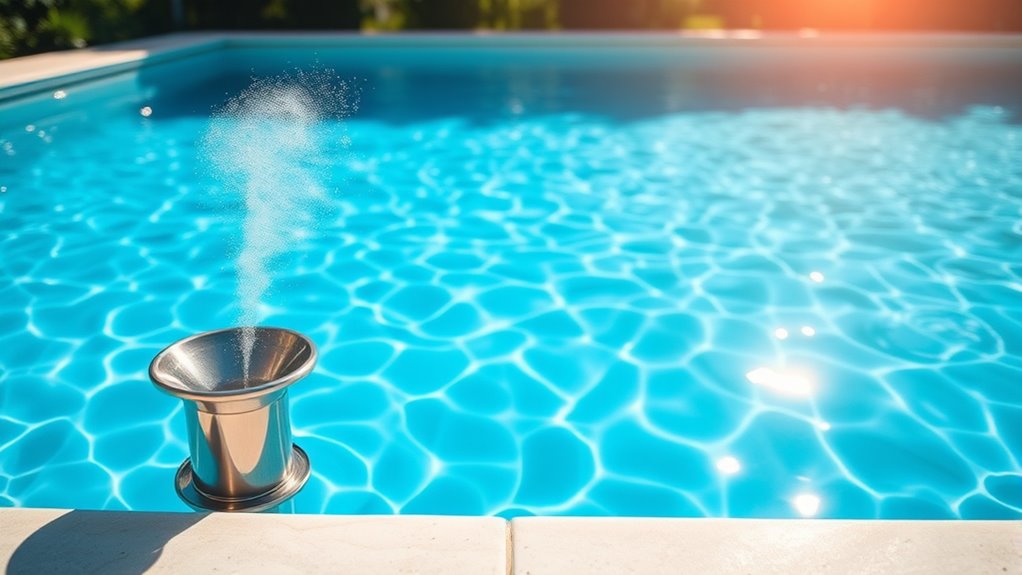
Before shocking your pool, you need to guarantee the water chemistry is balanced. Test the pH, alkalinity, and chlorine levels, and adjust them if necessary. Also, give your pool a thorough cleaning to remove debris and dirt that could hinder the shocking process. Ensuring proper filter maintenance can enhance the effectiveness of the shock treatment. Additionally, understanding the importance of data privacy challenges helps ensure your pool’s chemical data remains secure during testing and adjustments.
Check Water Chemistry
Ensuring your water chemistry is balanced is essential before shocking your pool, as improper levels can diminish effectiveness and cause problems. Check these key parameters:
- pH levels should be between 7.2 and 7.6 to maximize sanitizer efficiency.
- Total alkalinity needs to be in the 80-120 ppm range to buffer pH fluctuations.
- Chlorine levels should be low (around 1-3 ppm) before shocking to prevent rapid depletion.
- Cyanuric acid should be under 100 ppm to avoid interference with chlorine’s ability to sanitize.
- Regular testing and maintaining proper water chemistry can help ensure your shock treatment works effectively and keeps your pool safe and clean.
Clean Pool Thoroughly
To effectively shock your pool, you need to start with a thorough cleaning to remove debris, dirt, and algae that can hinder the treatment’s effectiveness. Begin by skimming the surface to clear leaves, insects, and other floating debris. Next, vacuum the pool floor to eliminate settled dirt and algae. Brush the walls and tiles to loosen algae buildup and dirt, ensuring better chemical contact. Check your filter system and clean or backwash it as needed to improve circulation. Removing all debris and dirt allows the shock treatment to work more efficiently, ensuring even distribution and better sanitation. A clean pool surface helps prevent algae growth and ensures your shock treatment effectively sanitizes the water, leaving it clear and safe for swimming.
Step-by-Step Guide to Shocking Your Pool

Shocking your pool is an essential step to maintaining clean, clear water, especially after heavy use or stormy weather. To do it right, follow these steps:
- Test your water’s chemical levels, focusing on chlorine and pH.
- Calculate the right amount of shock treatment based on your pool size.
- Pour the shock evenly around the pool, preferably at dusk to prevent rapid dissipation.
- Run your pool pump for at least 8 hours to circulate and evenly distribute the chemicals.
Make sure to wear protective gear and avoid swimming until the shock has fully dissipated. By following this step-by-step process, you ensure your pool stays safe, clean, and inviting.
Best Times to Shock Your Pool

Timing is crucial when shocking your pool to maximize effectiveness and safety. The best times to shock are usually in the evening or at night, after sunset, when sunlight won’t break down the chlorine quickly. Shocking your pool during this time allows the chemicals to work effectively without interference from UV rays, which can reduce chlorine levels. You should also consider shocking after heavy use, such as parties or pool gatherings, to eliminate organic contaminants. Additionally, shock your pool if you notice cloudy water, algae growth, or a strong chlorine odor. Avoid shocking immediately before swimming; wait at least 8 to 12 hours afterward to ensure the chemical levels return to safe, balanced levels. Proper timing guarantees your pool remains clean and safe for everyone.
Safety Precautions When Shocking
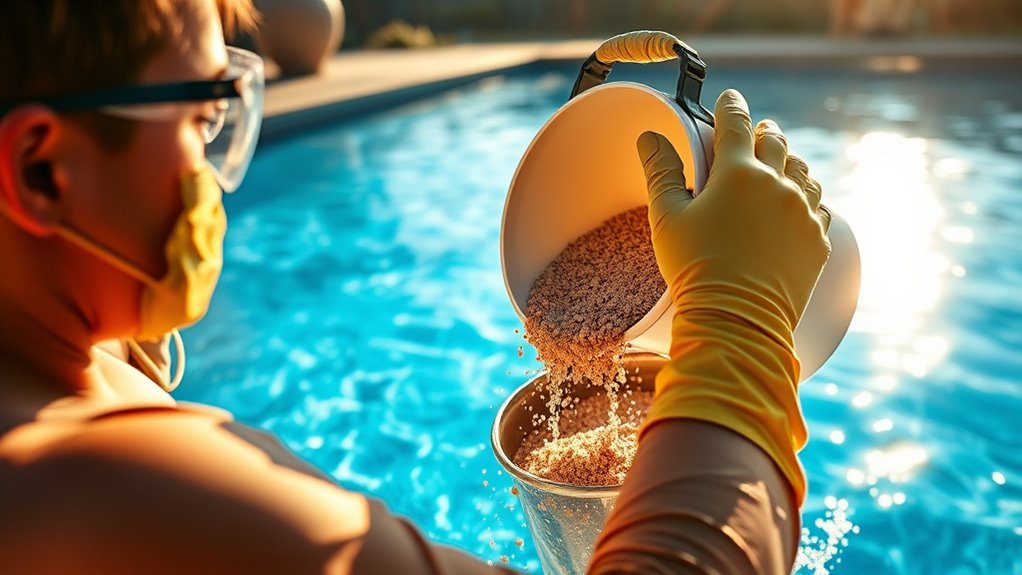
Since chemicals in pool shock can be hazardous if mishandled, it’s essential to follow proper safety precautions. First, always wear protective gear like gloves and goggles to prevent skin and eye contact. Second, keep the pool area well-ventilated to avoid inhaling fumes. Third, store shock chemicals safely away from children and pets, preferably in a locked cabinet. Fourth, never mix different chemicals, as this can cause dangerous reactions. Before shocking, turn off pool equipment and avoid swimming until the chemicals fully dissipate. By following these steps, you minimize risks and ensure a safe shock process. Remember, handling pool shock responsibly protects both you and your loved ones from potential hazards.
Post-Shock Pool Care and Maintenance
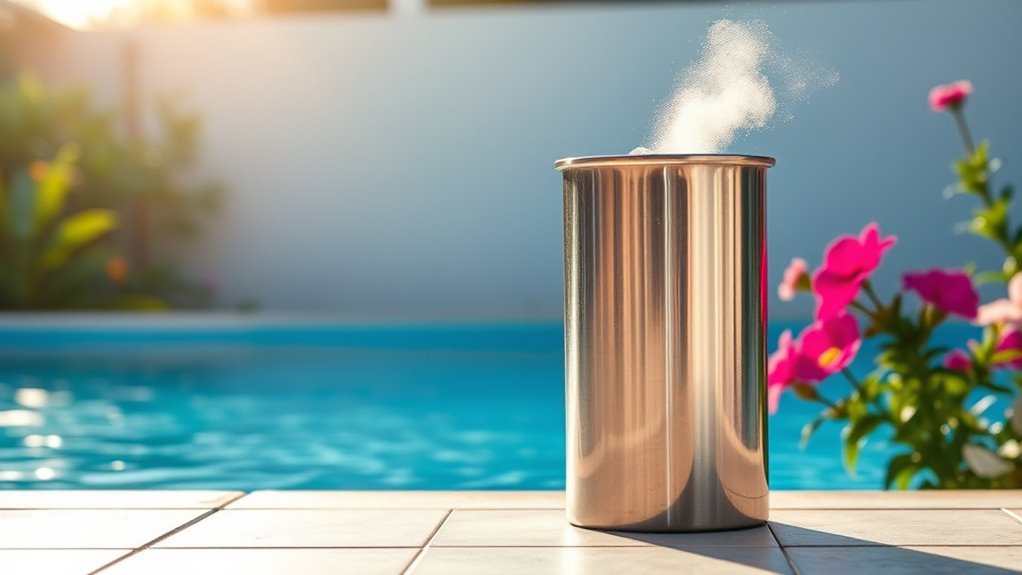
After you’ve finished shocking your pool, it’s important to give the chemicals time to dissipate before resuming normal use. During this waiting period, your pool water is healing, restoring clarity and balance. Patience now ensures safe, invigorating water later. To help you stay motivated, consider how your efforts will lead to revitalizing, inviting swims that boost your mood and relaxation.
| Your Effort | Your Reward |
|---|---|
| Waiting | Crystal-clear water |
| Testing | Peace of mind |
| Circulating | Sparkling, balanced water |
| Patience | Safe, revitalizing swims |
| Regular Care | A beautiful backyard oasis |
Troubleshooting Common Shocking Issues

Even with careful shocking, you might encounter issues like cloudy water, lingering odors, or algae blooms. To troubleshoot, start by checking your water chemistry—pH levels should be balanced, and chlorine residuals verified. Next, inspect your filtration system: a dirty filter can hinder clarity. If algae persist, boost your chlorine levels and brush the walls thoroughly. For odors, ensure proper ventilation and consider adding a sequestering agent to remove organic contaminants. Lastly, confirm that your pool’s circulation is effective; poor circulation prevents disinfectants from working properly. Here’s a quick checklist:
- Verify pH and chlorine levels
- Clean or replace the filter
- Brush and scrub surfaces to remove algae
- Improve circulation with proper pump operation
Addressing these issues promptly keeps your pool safe, clear, and inviting.
Frequently Asked Questions
How Often Should I Shock My Pool During the Swimming Season?
You wonder how often to shock your pool during swimming season. Typically, you should shock your pool once every 1-2 weeks to maintain clear, healthy water. If you notice algae, cloudy water, or after heavy use, shock it more frequently. Always test your water first to determine if shocking is necessary. Regular shocking keeps bacteria and algae at bay, ensuring a safe and inviting swimming environment.
Can I Swim Immediately After Shocking My Pool?
You can’t swim immediately after shocking your pool. Once you add shock, you need to wait until the chlorine levels drop back to a safe range, usually about 24 hours or until the chlorine smell lessens. This guarantees the chemicals are balanced and safe for swimming. Always test your water before diving in, and follow the instructions on your shock product for the best results.
What Are the Signs of Over-Shocking My Pool?
They say, “Too much of a good thing can be bad,” and over-shocking your pool is no exception. If your water turns cloudy, develops a strong chemical smell, or you notice irritation in your eyes or skin, you’re likely over-shocking. You might also see high chlorine levels on your test strip. These signs indicate it’s time to balance your water carefully before swimming again.
How Long Should I Wait After Shocking Before Testing Water Quality?
After shocking your pool, you should wait at least 24 hours before testing the water quality. This allows the chemicals to fully circulate and neutralize. During this time, avoid swimming and keep the pump running to help disperse the shock evenly. Testing too soon might give inaccurate readings, so patience is key. Once enough time has passed, your water should be clearer, and test results more reliable.
Can I Shock My Pool in Direct Sunlight?
Sure, go ahead and shock your pool in direct sunlight—because who doesn’t love turning a pristine oasis into a science experiment? But seriously, sunlight can cause the shocking chemicals to dissipate faster, making it less effective. For best results, shock your pool in the evening or on a cloudy day. That way, your chemicals work their magic without the sun stealing the spotlight—and your chlorine.
Conclusion
Shocking your pool is the superhero move that keeps your water crystal clear and sparkling like a diamond. By understanding when and how to do it properly, you’ll prevent algae invasions and keep your swimming oasis safe and inviting. Remember, neglecting this essential step is like inviting chaos into your backyard paradise. Stay vigilant, follow the steps, and enjoy a pool so pristine, it’ll outshine the sun itself!
